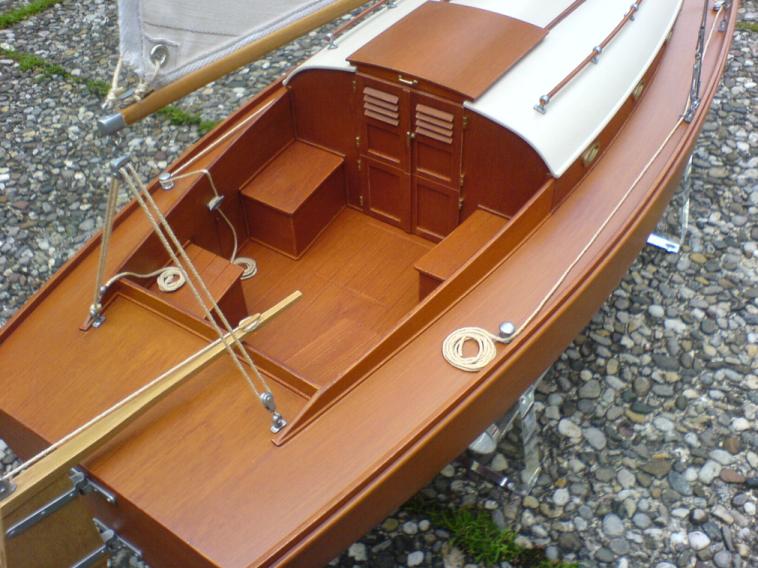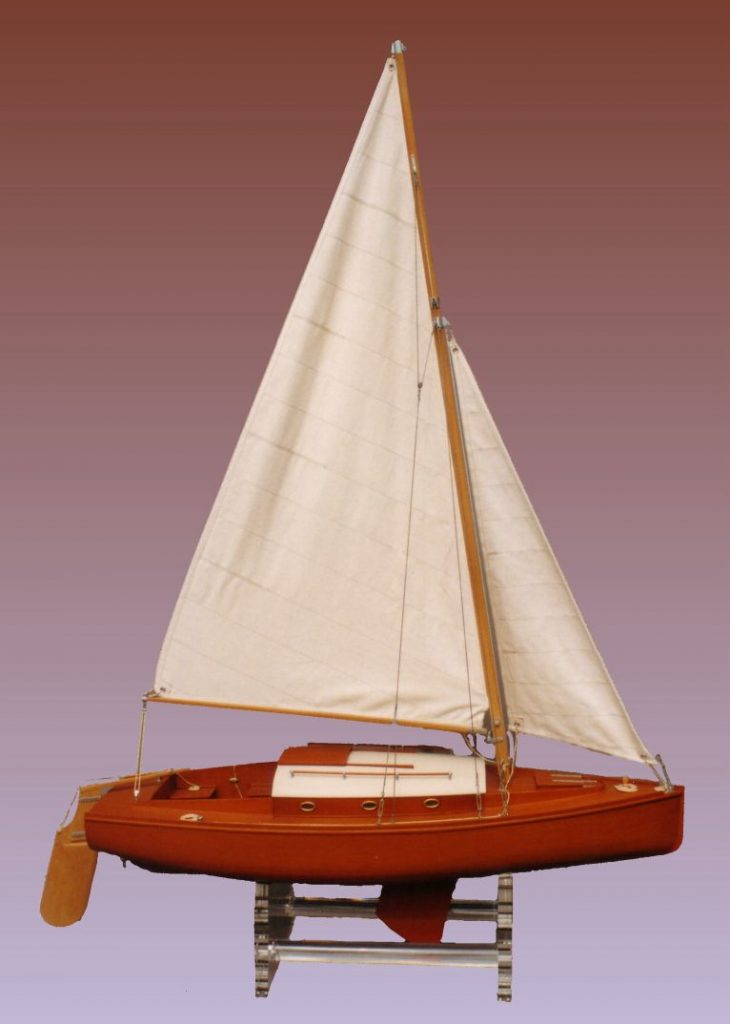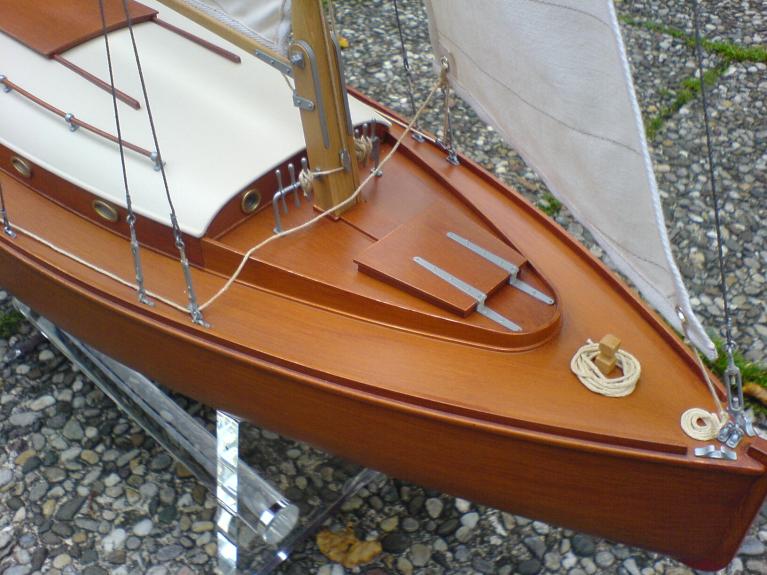“[…] and the sailing boat that I’ve been given by the high finance! You will go into raptures when you (hopefully) visit me next year.”
Albert Einstein to his sister Maja, 1929
Albert Einstein’s “Tümmler” (porpoise)
In August 1929 Elsa Einstein wrote in a letter from Caputh to Einstein’s sister Maja: “[…] Our ship is magnificent; Albert has his own landing stage at the garden, he enjoys this sailing happiness very intensively. The sailing ship is a gift from very rich friends (15,000 marks!). I write this pretentious remark for you to get an inkling what proud ship your brother is sailing.”
Einstein’s sailing boat, which he lovingly called “my thick sailing boat”, was given him by his friends for his 50th birthday on March 14 in 1929. The friends were the bankers Henry Goldman (1857-1937), Otto Jeidels (1882-1947) and Siegfried Bieber (1873-1960).
On March 21, 1929, Einstein thanked Siegfried Bieber for the gift in a letter: “Dear Mr. Bieber! I feel compelled to express my utmost gratitude for the wonderful gift that you, Mr. Jeidels and Mr. Goldmann have given me. […]”
In the magazine “Die Yacht” (The Yacht) , nr. 50/1929 the sailing boat was described in detail. The article and the pictures on this website (blue box) are published with friendly permission of the editorial department of the magazine “Die Yacht”. The original article was written in German.
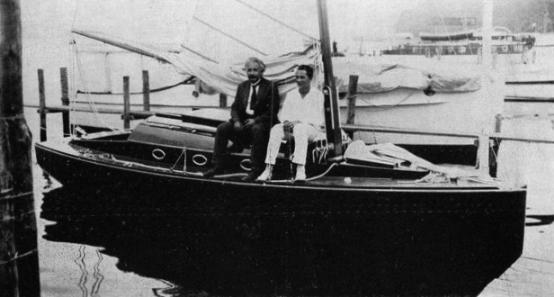
20-m²-sailing boat for professor Albert Einstein
Of the three owners of the “Berliner Handelsgesellschaft” (Berlin Trading Company) it was the ship-building engineer Adolf Harms who received the honourable order to design a boat as present for the famous scientist Albert Einstein’s 50th birthday.
They agreed on a sailing boat with auxiliary engine and a sailing area that should be kept as small as possible. Furthermore it was required that the operation of the sailing boat would be easy and not exhausting.
The draft next to this text was developed from these prerequisites. The draft was built at the shipyard of Berkholz & Gärsch under supervision of the designer. In summer it was delivered to Albert Einstein who was completely satisfied with it.
The engine should be equipped with a starting motor and a generator. If possible it should not be seen anywhere in the sailing boat. Thus the designer made the proposal that a slightly bigger freeboard was used, which made it possible to lay the floor in the cockpit so high that the engine could be placed completely beneath it; at the same time the cabin construction could be kept relatively low.
Contrary to the original equipment the sailing boat was equipped with a bathroom whose place is visible from the cover. An originally intended buffet had therefore to be left out; it was replaced by a smaller shelf for glasses and a shelf for three shag pipes.
One additional remark has to be made concerning the equipment that is mainly visible from the drafts: both cupboards under the side deck at port and starboard were enlarged for 4 persons to accommodate cups, plates etc. All the necessary cutlery, washing bowls, brushes, leather cloth etc were delivered with the cupboards for the sailing boat to be completely ready for use.
The space under the afterdeck can be locked and serves as freight hold for fender, bucket, spare petrol can and other similar things.
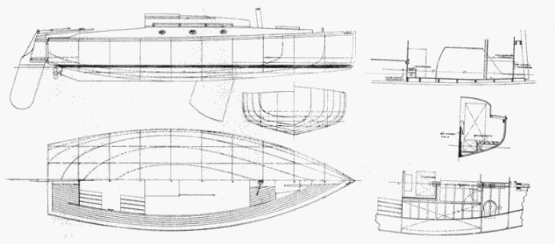
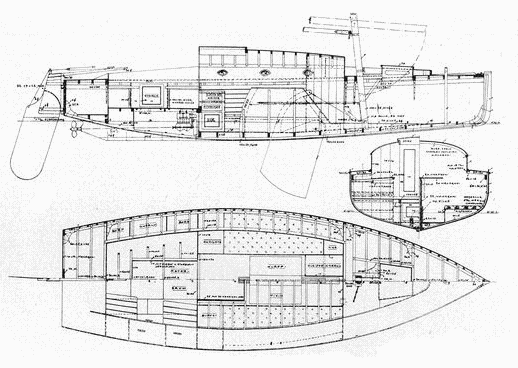
In the cabin at port there is a sideboard built in, in which a spirit stove with zinc plate bowl is arranged in such a way that it becomes visible when moving the upper plate of the sideboard and is ready for use. When the spirit stove is not needed it is not visible at all.
The engine, a 2-cylinder-two-stroke 5/6 hp F. Z., was built in such a fashion that it is absolutely heat resistant. This was achieved by insulating it to all sides. The walls of the bulkhead were lined with asbestos and sheet metal so that the fuel tank, which was arranged at port next to it, is completely separated from the engine. The generator and the starting motor are situated in the engine compartment.
The engine is accessible very easily after removing the planks, which are also heat-resistant from underneath. The lever for the reversible propeller which can be feathered is removable so that it disappears completely when sailing; the necessary slot is closed by a copper plate. The planks are built in such a fashion that the engine can not get wet when it rains.
The engine has proved of value at the crossover from east to west, it sailed perfectly.
The cabin contains two comfortable sleeping places with blue covers, whose colour matches very well with the mahogany of the interior decoration.
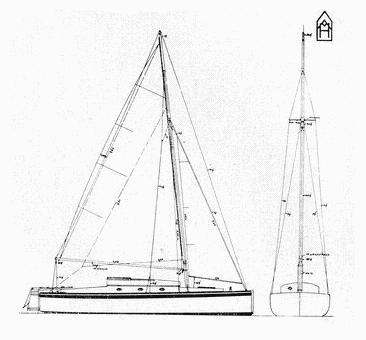
The cabin roof consists of two layers of wood with an interim layer of water-tight canvas. The lower layer consists of maple wood, which together with the threefold glued planks out of mahogany gives a good composition of colours. The upper layer consists of pure mahogany.
At port there is a roomy wardrobe. Next to it is a small wardrobe which serves for accommodating removable electric position lamps.
The sailing boat has proved its value under all wind conditions from about 0 to 10 m/sec when all sails are set and sails very well, even with the high weight of the sails. This is also true for sailing at lull.
It was a special wish of professor Albert Einstein that the sailing boat was equipped with a Bermuda rig. To facilitate the setting of the mast, the bibs are situated that high that the boom could be mounted on a pivot and furthermore it was obtained that the lower end of the mast situated in the bibs could become about 1,15 m long and could be equipped with a lead weight at the lower end corresponding to the weight of the mast. Thus an easy setting of the mast could be achieved.
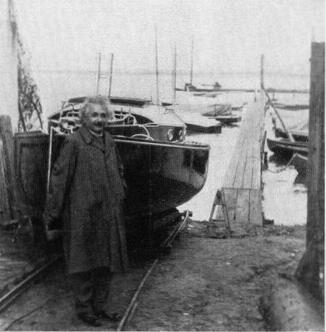
Albert Einstein was very content with his sailing boat. In the autumn of 1929 he wrote in a letter to the ship-building engineer Adolf Harms:”[…] The sailing boat has my highest respect and also the respect of all the people who have been sailing with it. It combines a high degree of stability with a relatively high mobility and comfort for the operation.”
Rudolf Kayser, the husband of Einstein’s stepdaughter Ilse wrote in his Einstein biography under the pseudonym Anton Reiser in 1930: “While his hand holds the rudder Einstein explains with joy his latest scientific ideas to his present friends. He sails the boat with the skill and fearlessness of a child. He himself hoists the sails, climbs around on the sailing boat to tighten the tows and ropes and handles bars and hooks to set sails. The joy with this hobby can be seen in his face, it echoes in his words and in his happy smile.”
But the joy with his sailing boat was not to last very long.
After the national socialists seized power in January 1933 – when Albert Einstein stayed in America – his complete property was “confiscated by the national socialists and kept in favour of the Prussian state”, also his beloved “thick sailing boat”.
To be precise, Einstein’s sailing boat was confiscated twice – first by the Prussian state and then by the Gestapo.
Einstein had still tried to save his sailing boat from the access of the Gestapo in the last minute by asking Hermann Schumann to take his sailing boat to the Netherlands where it would be safe because the anchorage of Einstein’s sailing boat was in Hermann Schumann’s shipyard in Potsdamer Strasse. As such an action held danger, Schumann didn’t give in to Einstein’s wish.
The seizure of the sailing boat by the police was executed on June, 12 in 1933. The following announcement could already be read in the Vossiche Zeitung on the same day:
“Einstein’s speed motor boat confiscated. The speed motor boat of professor Einstein which was moored at a shipyard in Caputh near Potsdam was confiscated and seized for the Reich. Einstein is said to have planned to smuggle the sailing boat into a foreign country. The sailing boat is worth RM (Reichsmark) 25,000.”
It is fascinating that Einstein’s sailing boat was transformed into a speed motor boat and the stated value of the sailing boat in the announcement was higher than the value as new.
Though he did not think of a success, Einstein had – for reasons of precaution – authorized his son in law Rudolf Kayser to act for him to prevent a possible seizure of his possessions, but it was in vain.
In January 1934 it was ordered that the sailing boat was to be sold if the police did not see any kind of use. When selling the sailing boat, however, it should be prevented “that the sailing boat was once again bought by public enemies.”
In the Potsdamer Tageszeitung Einstein’s “Tümmler” was announced for sale on February 28 in 1934.
“Sailing boat with starter motor, additional equipment, immediately, massively built of mahogany, in good condition, 20 m² sails, moors Caputh, Potsdamer Straße 27. Offers to the local government of Caputh up to March, 8.”
The first offer of RM 1200 came at the beginning of March from the dentist Dr. Wilhelm Fiebig from Nowawes near Potsdam. In contrast to the following two offers – a man from Potsdam offered RM 600 and a doctor from Berlin was ready to pay RM 1000 to RM 1200 – the offer from Dr. Fiebig was not signed with “Heil Hitler”.
After the period of time stated in the announcement had expired, the sports club of the Reichsbahn wanted to buy the sailing boat. It should serve there for training the young generation. The club offered RM 1300. Dr. Fiebig successfully fought this offer and increased his offer also to RM 1300. In May 1934 Einstein’s beloved “thick sailing boat” was sold to Dr. Fiebig for a price of RM 1300.
In 1945 Einstein asked the community of Caputh in a letter from the far away America for the whereabouts of his property, among other things also for the remaining of his “thick sailing boat”. The community officially investigated the whereabouts of the sailing boat, but the investigation was not successful. The trail of the sailing boat could only be followed until the end of the 30ies. What happened to the sailing boat after that time up to now and its whereabouts are unknown.
Illustrations Credits:
Courtesy of the magazine Die Yacht.
MODEL OF EINSTEIN’S „TÜMMLER“ – on a scale of 1:10
The model of Einstein’s „Tümmler“, which is shown here, was commissioned by the Landesmuseum für Technik und Arbeit in Mannheim, Germany, at the company Modellbau Atelier Birmann in Nuremberg and built on a scale of 1:10 with the help of the article from the magazine “Die Yacht” (The Yacht) shown above, in which the boat is pictured several times and describes in detail. After completion it was for the first time presented to the public in 2005, the Einstein year, in the exhibition „Einstein begreifen“ (Understanding Einstein) in the „Landesmuseum“ (State Museum) in Mannheim, Germany. Since the middle of May 2006 it has found its final anchorage ground in Caputh, Germany. In possession of the Initiativkreis Albert-Einstein-Haus Caputh, it can be visited in the exhibition Einstein’s Sommer-Idyll in Caputh, in the community centre opposite Castle Caputh.
01/24
Illustrations Credits:
Courtesy of the company Modellbau Atelier Birmann, Nuremberg
and the Initiativkreis Albert-Einstein-Haus Caputh
Bibliography:
| Michael Grüning | Ein Haus für Albert Einstein | Berlin 1990 |
| Siegfried Grundmann | Einsteins Akte | Berlin 1998 |
| Anton Reiser | Albert Einstein. A Biographical Portrait | New York 1930 |
| Magazine: Die Yacht | 20-m²-Jollenkreuzer für Professor Albert Einstein | Hamburg 1929 |
| Hrsg. Diana Kormos Buchwald, Ze’ev Rosenkranz, József Illy, u. a. | The Collected Papers of Albert Einstein, Volume 16 | Princeton 2021 |


 DEUTSCH
DEUTSCH